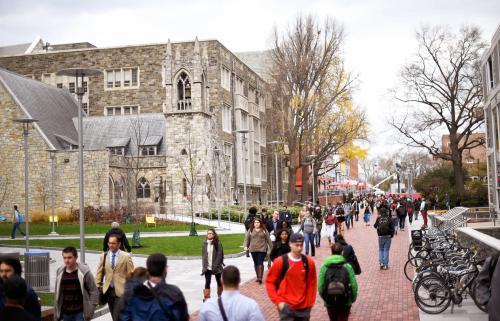Well before COVID-19, politicians and business leaders expressed concern about the gap between the skills employers need to maximize productivity and the skills possessed by available workers. The pandemic has only exacerbated these gaps, with over 10 million job openings and six million unemployed workers by the end of October 2022.
Community college noncredit Career and Technical Education (CTE) programs are an important contributor to skill and workforce development. Approximately five million students enroll in community college noncredit programs nationally (more than half in CTE programs), which represents 41% of the total enrollments in the community college sector. CTE programs are highly focused on job training and are much shorter in duration than the typical community college or university degree program. In Virginia, two of the most popular CTE programs are commercial driver’s license and certified medical assistant training, which respectively consist of 168 and 180 contact hours (for comparison, full-time students complete about 150 contact hours in a semester). Noncredit CTE programs are also popular among working adults: In Virginia, the average age of students enrolled in noncredit CTE programs is 35 years old (authors’ calculations).
The federal and state governments increasingly prioritize workforce training in their policy agendas, such as the Biden Administration’s Talent Pipeline Challenge. Yet we know next to nothing about the composition of students who participate in these programs; the rates at which students complete programs and earn workforce-relevant credentials; and whether CTE program participation leads to subsequent education and training or improved workforce outcomes. While states have made substantial investments and progress in building data warehouses for their credit-bearing postsecondary education institutions, most of these longitudinal data systems do not include data from noncredit CTE programs.
In 2016 the Virginia legislature launched an innovative pay-for-performance funding mechanism, the New Economy Workforce Grant (WCG), to expand participation in community college noncredit CTE programs, or “FastForward programs,” that lead to an industry-recognized credential in one of the high-demand fields, as identified by the Virginia Workforce Board. In this model, costs are shared among the state, the students, and the training institution, where the specific amounts of funding each party pays is based on student performance, creating financial incentives for programs and students to make the programs accessible and boost completion rates. Specifically, upon enrolling, eligible students are required to pay only one third of the total program cost, which was an average of $802 in FY2022. If the student completes the program, the state provides one third of the cost to the training institution. If the student further receives a third-party, industry-recognized credential within six months of program completion, the state will pay two thirds of the cost to the training institution, enabling the training institution to be reimbursed fully. One important implication of the WCG is a mandate on systematic, statewide collection of student-level noncredit CTE data on program enrollment, completion, industry credential attainment, and labor market data.
We capitalize on these data to generate evidence on the academic and labor market outcomes of students enrolled in FastForward programs. We focus this blog post on our analyses related to participant composition, program success, and the relationship between noncredit and credit enrollment. Future work will investigate the labor market impacts of FastForward participation and the impacts of Virginia’s unique pay-for-performance model for funding noncredit CTE programs.
New evidence on community college CTE program participation and success
We focus on three primary insights about FastForward programs in Virginia. For a technical summary of our data, methods, and results, visit PERI².
- FastForward programs attract and enroll a different segment of the population than credit-bearing programs at community colleges.
As we show in Figure 1, FastForward programs in Virginia enroll a substantially higher share of Black students, male students, and older students than short-duration, credit-bearing programs at community colleges, such as certificate programs in “office professional technologies” or in “advanced medical coder” (which require 20 credits and 16 credits, respectively). For instance, 33.9% of students enrolled in FastForward programs are Black, compared with 24.1% of students in credit-bearing programs. From a postsecondary educational access perspective, noncredit CTE programs such as FastForward may provide an important alternative pathway to skills and workforce opportunities for populations traditionally underrepresented in the credit-bearing sector.
- We observe little student flow from FastForward to the credit-bearing sector.
The existing literature suggests that an associate degree from community colleges can yield substantial labor market benefits to students. Accordingly, one goal policymakers and funders have for noncredit programs is for them to serve as a potential “springboard” for students to earn additional credits and credentials in for-credit programs. Yet our analyses suggest that most students do not appear to be approaching noncredit programs in this way. Figure 2 shows that the majority of FastForward students—60.7%—have no prior or subsequent enrollment in the credit-bearing sector. And while roughly one third (25.9% plus 10.6%) of FastForward enrollees had prior credit-bearing enrollment, only a small share of those students earned a degree or certificate from this prior enrollment. This suggests that noncredit may provide a pathway to training and industry credentials for students who were not successful on the credit-bearing side. However, very few FastForward enrollees—less than 14% (2.7% plus 10.6%)—pursue subsequent training in the credit-bearing sector. This is true despite increasing state efforts to grow the share of workers that “stack” credentials to maintain job-relevant skills in a rapidly transforming labor market.
- Program completion and industry credential attainment rates are high in FastForward programs
FastForward program completion and industry credential attainment rates are much higher than completion and attainment rates from the credit-bearing sector (Figure 3). For instance, 70.1% of FastForward students earn an industry credential within six months, compared to 31% of students who earn a college-awarded certificate within two years of starting a short-term certificate in a credit-bearing program. One obvious reason for higher completion rates is that noncredit CTE programs, such as FastForward, are typically much shorter in duration. But the FastForward program completion rate (95.2%) is also substantially higher than completion rates for noncredit CTE programs in other states (typically around 75%). Another plausible explanation for the high completion rate is the dual financial incentives embedded in the WCG funding model. If a student does not complete their program, then: 1) they are required to repay another one third of the total cost to the training institution; and 2) their institution misses out on state funding. Community colleges are fully reimbursed by the state only if a student successfully completes their training and earns the third-party industry credential.
Underlying the overall high industry credential attainment rates is important variation between programs and student groups in credentialing. As we show in Figure 4, some highly enrolled programs, like Clinical Medical Assistant, have high industry credential attainment rates (80.3%). However, other highly enrolled programs, like Certified Nurse Aid, have much lower attainment rates (48.0%).
Policy implications
Many of the patterns related to enrollment and success commonly associated with the credit-bearing sector of community colleges do not seem to apply to FastForward programs in Virginia. They enroll students typically underrepresented in credit-bearing programs and have much higher program completion and credential attainment rates. While our analyses do not yet speak to the labor market impacts of FastForward programs, the descriptive insights still motivate several potential areas for further policy attention:
- We observe gaps in industry credential attainment that merit further investigation and potential intervention. Why, for instance, are industry credential attainment rates substantially lower for Black students (59.5%) than white students (73.8%), despite more comparable program completion rates (91.3% and 95.2%, respectively)? What forms of additional support for Black FastForward program completers might lead to higher credentialing?
- What FastForward program factors are associated with higher industry credential rates, and what aspects of programs might hinder students from obtaining an industry credential after completing their program? (This is a question we will investigate in upcoming work with MDRC.)
- Would more proactive outreach and advising about opportunities to stack credentials lead more students to use noncredit CTE programs as a stepping stone to the credit-bearing sector?
Millions of students pursue CTE training at community colleges each year, and these programs have the potential to address important skills gaps in the U.S. economy. Building further evidence on noncredit CTE programs—in Virginia and more broadly—can help to guide future policy investments in effective workforce development.
The Brookings Institution is committed to quality, independence, and impact.
We are supported by a diverse array of funders. In line with our values and policies, each Brookings publication represents the sole views of its author(s).
















